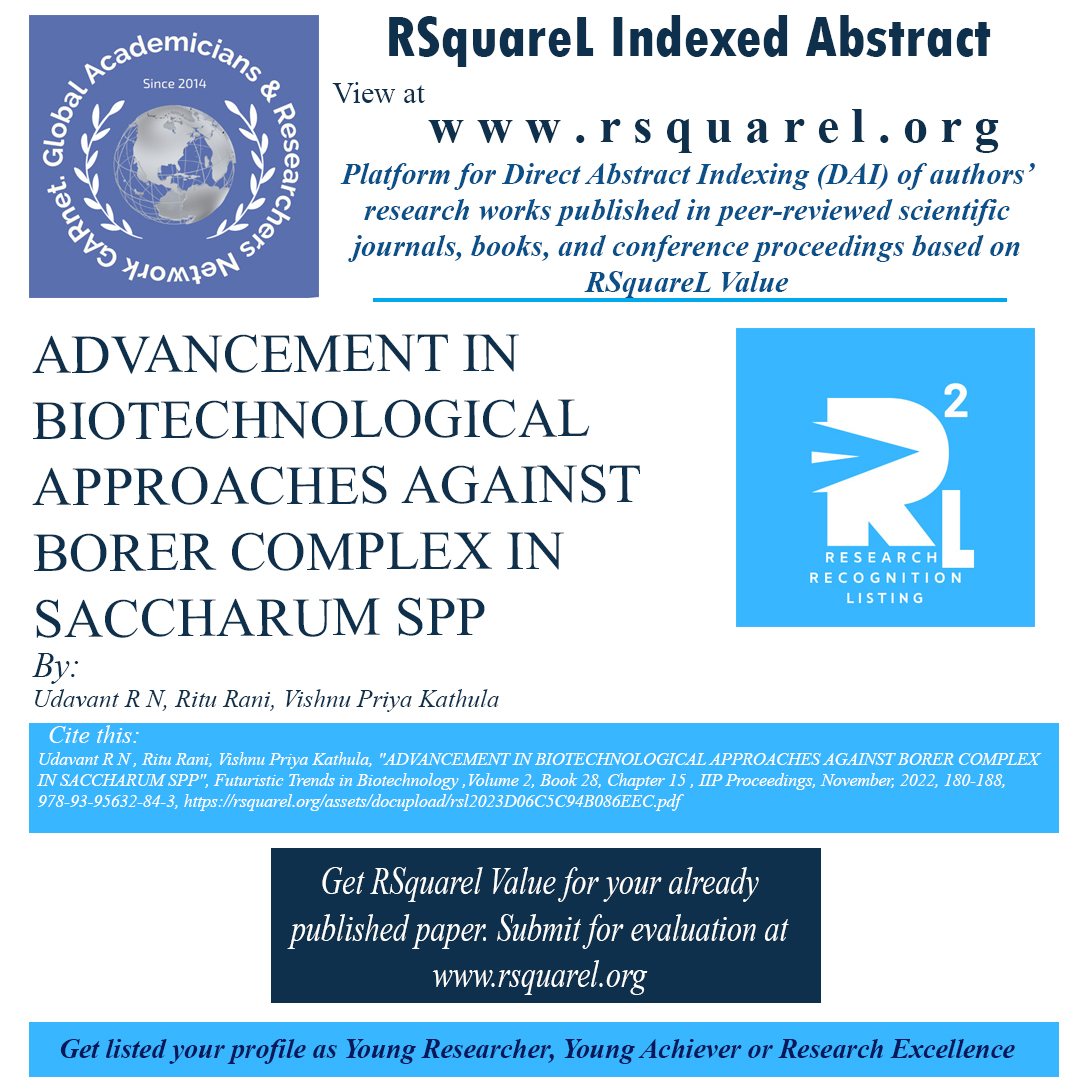editedbook
Publication: IIP Proceedings Year: 2022, Month: November Page No: 180-188, ISSN/ISBN: 978-93-95632-84-3, DOI/Link: https://rsquarel.org/assets/docupload/rsl2023D06C5C94B086EEC.pdf
ADVANCEMENT IN BIOTECHNOLOGICAL APPROACHES AGAINST BORER COMPLEX IN SACCHARUM SPP
Area/Stream: Biotechnology, Authors: Udavant R N , Ritu Rani, Vishnu Priya Kathula Keywords: Biotechnologicall Approach, Saccharum Spp Book Name /series: Futuristic Trends in Biotechnology ,Volume 2, Book 28, Chapter 15Publication: IIP Proceedings Year: 2022, Month: November Page No: 180-188, ISSN/ISBN: 978-93-95632-84-3, DOI/Link: https://rsquarel.org/assets/docupload/rsl2023D06C5C94B086EEC.pdf
Abstract:
Sugarcane (Saccharum spp.), a perennial grass, is widely grown as a vegetatively propagated crop in the tropics and sub-tropics of the world. It generates 40% of the globe's bio-fuel output as well as about 80% of the saccharin demands. By introducing the E20 program, India's new biofuel policy also emphasizes the manufacturing of biofuels. The 10% ethanol mix in fossil fuels under the Government of India's E10 initiative was successfully finished in March 2022. (ESY 2021-22). According to government estimates, a successful E20 program may reduce import costs by 30,000 crore rupees. Each year, a variety of factors impact cane and sugar output. One of the many biotic and abiotic constraints limiting sugarcane output is insect pests, which cause more than 10% of crop losses globally [6]. The primary biotic agents of this loss in subtropical and tropical regions are top shoot borer (Scirpophaga excerptalis), stalk borer (Chilo infuscatellus Snellen), internode borer (Chilo sacchariphagus indicus). Borers' immediate effects include dead hearts, poor tillering, tunneling of leaves and stalks, stalk breaking, side shoots, and roots; they also cause cane weight loss, eye bud sprouting, and poor juice quality, all of which contribute to output losses. The invasion of opportunistic microorganisms like Fusarium moniliformae [Went] & Colletotrichum falcatum [Sheldon] through the holes of borers is what causes indirect harm. The expense of agriculture is greatly increased by the chemical and biological treatment of these pests. The most effective and affordable pest management strategy is the creation of resistant cultivars. Specifically, interspecific hybridization between Saccharum officinarum, which has a high sugar content, and Saccharum spontaneum L., which includes resistance genes, is the principal method used to generate standard sugarcane cultivars. The transmission of undesirable characteristics together with beneficial features results from this strategy of rearranging the DNA of both parents. To solve this issue, much backcrossing is needed, which is quite challenging and time-consuming. Additionally, at a certain point, crop output and quality can only be increased by using cutting-edge technologies with diverse tissue culture techniques and genetic engineering owing to sugarcane's limited genetic diversity and complex genomic structure. Transgenic technology has a tremendous potential to create borer resistance with the aid of many transformation procedures such as biolistics, electroporation, agrobacterium-mediated, and genome editing tools. The present genomics efforts that are illuminating the structure, function, and interactions of sugarcane genes have the potential to transform crop development initiatives and might prove helpful in breeding superior varieties with desired traits like insect resistance.
Cite this: Udavant R N , Ritu Rani, Vishnu Priya Kathula,"ADVANCEMENT IN BIOTECHNOLOGICAL APPROACHES AGAINST BORER COMPLEX IN SACCHARUM SPP", Futuristic Trends in Biotechnology ,Volume 2, Book 28, Chapter 15 , November, 2022, 180-188, 978-93-95632-84-3, https://rsquarel.org/assets/docupload/rsl2023D06C5C94B086EEC.pdf
Views: 4172
Download File
News
